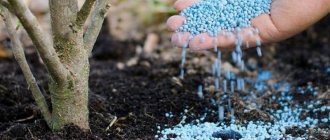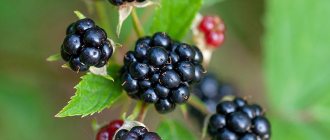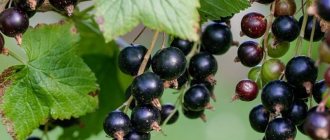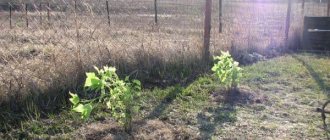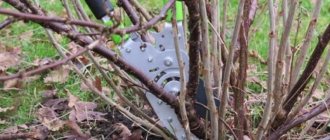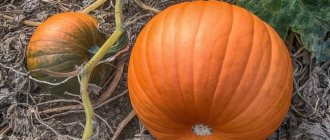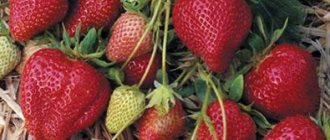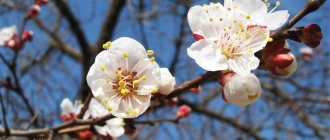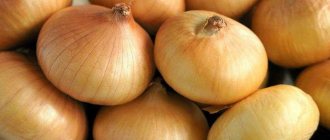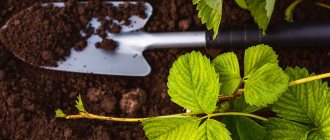Care depending on the variety
Caring for blackberries, such as watering, preparing for winter cold, feeding with fertilizers, is common for all varieties. There are some differences in pruning. For tall species, bush formation is required every year. Pruning involves pinching off the tops of the main branches. This will stimulate the growth of young branches and the bush will be more lush.
The berry growing as a sexton is unpretentious to the external growing environment. Varieties growing in the country, on the contrary, are capricious. Therefore, in order to properly care for garden blackberries, you need to know all the intricacies of care.
Blackberries are a drought-resistant plant because their roots extend several meters into the ground. Breeders have also developed garden varieties that tolerate lack of moisture in the soil. However, it needs to be watered. The plant experiences particular sensitivity to lack of moisture during the period of flowering and fruit ripening. The main rule of watering is moderation. Excess water will lead to rotting of the roots and death of the bush.
Flowering garden blackberry
The best amount of water for the bush during fruit formation is 15-20 liters per week. At other times, it is necessary to assess the condition of the soil and not allow it to become too dry.
During the season, it is necessary to carry out several soil loosening procedures. Depth 10 cm. At the same time, all weeds are removed. Loosening is especially important in the fall so that the soil around the roots freezes less in winter. This crop does not tolerate severe frosts. Therefore, the bush cannot be left open during the cold period. To preserve the plant, it must be covered for the winter.
Preparing blackberries for winter
The process of preparing for wintering consists of the following stages:
- press the shoots to the ground. Flexible branches bend down without much difficulty. To do this, they are tied together in several pieces. In those types of crops that have erect branches, pressing is carried out gradually: during the end of the growing season, small weights are tied to the tops, under the weight of which they will bend down. The procedure must be done until the air temperature drops to -1 degree. Otherwise, the shoots lose their elasticity and become brittle;
- securing branches to the surface of the ground with hooks;
- a shelter that can be built from spruce, pine, hay, vegetable tops, sawdust, peat, humus;
- For better thermal insulation, the crop can be covered with snow.
Do not cover the culture with film. The blackberries will rot under it, and moisture is a good environment for fungus to multiply. The most unfavorable time is the beginning of winter without snow. Therefore, the sheltering process should be done until the cold period sets in.
How to cover shrubs in winter
Garden blackberries: pruning and preparing for winter
Caring for blackberry seedlings in the fall consists of weeding, watering (as necessary so that the soil does not dry out), loosening the soil and mulching; it is a good idea to protect the bushes from insects hiding in the soil before wintering. To destroy pests, each bush is periodically watered before covering with a solution of half a tablespoon of 3% hydrogen peroxide per liter of water. The same liquid can be used to treat the above-ground part of the plant to prevent diseases.
In subsequent years, the bushes are watered 3 times a season, the roots of the bush go deep into the ground, where they receive the necessary moisture. Even with rare and meager watering, blackberries grow in one place for up to 9–11 years. The last watering is carried out a couple of weeks before the onset of frost, and fertilizers are applied simultaneously with the procedure (potassium-phosphorus without chlorine). Under each bush you can carefully dig a small amount of a mixture of superphosphate and compost.
Pruning blackberries in autumn
Forming a bush in the fall helps blackberries to overwinter well and form fruit buds. In addition to maintaining productivity and increasing yield, pruning will be the key to proper, uniform nutrition of the bush, providing sunlight to fruitful branches, and obtaining earlier, tasty berries. Pruning prickly blackberries is especially important; if the bushes grow too much, caring for them and picking berries will become quite difficult. Autumn pruning is carried out from mid-September to the end of October (immediately after the entire harvest is harvested).
On a note!
Autumn pruning strengthens the frost resistance of the bushes, and in the spring it is recommended to clean blackberries from branches that have not overwintered.
Before pruning, you need to determine the optimal load of the bush. The root of a healthy, mature plant is capable of providing food for no more than 8 fruit-bearing shoots; about 10 branches are left for wintering, providing a small reserve in case of freezing. All weakened stems are removed; sparse but healthy bushes are more productive. Let's look at the 5 golden rules for pruning blackberries:
- During the first year, all inflorescences are picked off during the season to stimulate root growth.
- In the second year, in the spring before the beginning of the growing season, the stems are shortened to 1.5 or 1.7 m. Sections are made above the bud.
- After wintering, the frozen sections of the stems are removed to the living bud. In the first half of June, the bush is thinned out - young shoots are removed, leaving no more than 8 best shoots for creeping varieties and about 5 for upright ones. The tips of young stems are shortened by 6 or 8 cm (a centimeter above the bud).
- In the fall, fruit-bearing branches are cut out at the root, as well as underdeveloped shoots or those affected by diseases and pests.
- Remontant blackberry bushes are cut out completely.
To ensure that blackberries get stronger faster after pruning, use only sharp scissors or pruning shears without gaps between the blades. The branches are removed completely; even short stumps cannot be left; if the wood rots, there is a risk of developing dangerous diseases. It is strictly forbidden to leave all plant remains near the bushes; they are burned away from the blackberry beds.
How to cover blackberries
Autumn planting of blackberries involves organizing a reliable shelter. In warm regions with snowy winters, you can do without additional protection; a layer of mulch will be enough. Before wintering, the stems are shortened to 1.5–1.8 m. If in your area in winter the snow cover is less than 30 cm, then the seedlings must be bent to the ground, tied to pegs and covered with burlap, roofing felt or thick polyethylene. The ground should be covered with a layer of hay, straw, peat, spruce branches, corn tops or sunflowers.
Attention!
The importance of covering blackberries cannot be overestimated; most varieties of the crop bear fruit on last year's shoots, even slight freezing of the bush threatens to reduce the yield. Frost-resistant varieties can tolerate temperatures down to 20 degrees, and they also need to be protected.
It is necessary to cover blackberries immediately before the onset of frost; if the procedure is carried out too early, there is a risk that the shoots pressed to the ground will take root. In spring, the protection is removed immediately after the onset of above-zero temperatures, so that the branches do not overheat and the fruit buds do not rot. As they grow, the lashes are tied to supports. Blackberry shoots are difficult to bend, so the bushes are prepared for subsequent shelter in August - small weights are attached to the tips of annual branches, the stems will gradually bend.
Mistakes of caring for blackberries in the fall and preparing for winter
Beginners, and sometimes even experienced gardeners, complain that if all the rules for planting blackberries in the fall are followed, the shrub develops very poorly the following year and is constantly sick. The problem may lie in poor-quality planting material, but most often poor growth is a sign of improper care. What mistakes do gardeners make when growing garden blackberries:
- too dense planting;
- planting in a damp place (it is better to replant the bush immediately);
- incorrect crown formation;
- lack of normalization of shoots (overloading of the bush);
- untimely pruning.
When cultivating blackberries, every detail is important; many varieties and hybrids, although they are unpretentious, still require increased attention. Start growing berries only after carefully studying the theory of autumn planting and caring for blackberries. Take into account the climatic conditions of the region and the composition of the soil, only then will you be able to obtain excellent berry harvests every year.
Care at different times of the year
The main care of the crop is carried out in spring, summer and autumn.
Spring care
Spring care is about restoring the bush’s strength after the winter period. At this time, the crop must be provided with all the nutrients that will increase the yield.
The following activities are carried out in the spring:
- remove the shelter and carefully examine the shoots. Those branches that have mechanical damage, signs of frostbite or disease must be removed. Such shoots cannot be left on the bush, as they can cause crop disease, and also, if there is damage, the crop will waste energy on restoration, which will lead to a decrease in yield;
- abundant watering - 5 buckets per bush;
- prune (beginning of May): leave 6-7 shoots on one stem;
- secure the bushes with trellis wire at the top and bottom. Shoots with fruits are attached to the top, young branches are attached to the bottom;
- Fertilizing of the crop is carried out three years after planting. In spring, it is best to sprinkle ammonium nitrate under each bush. Then the crop is mulched with a 5 cm thick layer of compost or manure. These substances saturate the roots with useful substances.
Removing winter shelter from bushes and checking for mechanical damage to branches
Autumn care
It is also necessary to care for blackberries in the fall. The main essence of care during this period is preparation for frost. The following procedure is performed:
- The bush is being pruned. Those branches that bear fruit are removed, since they will not bear fruit next year.
- Irrigation and fertilizing with fertilizers are carried out before wintering. This will saturate the plant with nutrients during the winter period.
- The tree trunk circle is mulched with sawdust, straw or dry leaves.
- Next, steps are taken to bend down the branches and cover them, which are described above. Before bending down the branches should be treated with copper sulfate or fungicides in order to protect the plant from fungus.
Autumn pruning of the plant
Row care
The space between the blackberry rows also requires care: remove weeds, loosen the soil slightly. In the autumn period (October-November), the soil is plowed to a depth of 15-17 cm, adding phosphorus, humus, and potash fertilizers once over several years. Mulch the soil with organic matter (manure, peat), spreading it in both directions. These actions are carried out before the first shoots appear. Not all types of mulch may be suitable. For example, the slow decomposition of sawdust, bark, and mushroom compost protects against weeds and drought. The best material is grass and straw. They are placed on top of a layer of peat and humus. This mulch will protect against dryness and strengthen the effect of fertilizing.
Summer care
In summer, during the heat of June and July, when the temperature reaches +30 degrees, blackberries are watered at least three times a week. Pour a bucket of water onto one bush. Watering is done twice a day: in the morning and in the evening.
At normal air humidity and temperature no higher than +25 degrees, as well as in the presence of rain, you should refuse watering. This procedure is carried out only in cases where the soil dries out by about 15 centimeters.
Scheme of planting and watering blackberries
Blackberry care in autumn
Preparing blackberries for winter in the fall is aimed at high-quality insulation of the bush. Alas, out of the hundreds of existing varieties of blackberries, only a dozen can boast of relative winter hardiness, and therefore, even in the middle zone, this plant often dies, unable to withstand a mild winter.
Feeding blackberries in autumn
As with raspberries, blackberries need to be fed in the fall, but the fertilizer should not contain nitrogen. The best option would be kalimagnesia, kalimag, superphosphate (the amount is the same as for raspberries).
After applying fertilizer and weeding, it is worth mulching the ground around the bushes with dry sawdust or peat.
Pruning blackberries in autumn
Sometimes gardeners are tormented by the question of whether they prune blackberries in the fall or if they can skip this step in preparing for winter. Our answer is clear: yes, it is necessary to prune blackberries in the fall. Like raspberries, they bear fruit on the shoots of the second year of life, so the task of competent autumn pruning is to preserve green young stems and remove all woody two-year-old ones.
Of course, you can leave the blackberries without pruning, but in this case they will spend energy on maintaining viability in the trunks, which will no longer bear fruit, and therefore are useless for the gardener.
If you leave stumps when pruning blackberries in autumn, then next year the bush will reduce yield and may lose some of its varietal characteristics.
To properly prune blackberries in the fall you need:
- Remove all fruit-bearing branches cleanly (without stumps) immediately after picking the berries;
- remove all thin and short young shoots that did not have time to ripen during the season;
- remove damaged or diseased mature branches - they will not survive wintering and can infect other shoots;
- trim the tops of mature shoots - this will allow them next year to spend their energy on fruiting, and not on growing green mass.
Blackberry shelter for the winter
Covering blackberries is not so simple - depending on the variety, they can be creeping or erect. If your blackberry “crawls” along the ground, then covering it will not be difficult, because it is very resistant to damping off and will calmly accept covering with peat, sawdust, straw, or corn leaves.
But if its stems are as thick as a thumb and stand straight even without being tied to a trellis, then it is impossible to tilt them without preparation - they will break at the very base. In order for the blackberry to “lay down” on the ground, experienced gardeners begin to hang weights on it at the end of summer, then the tilt will be gradual and will not injure the shoots.
After the trimmed blackberry bushes have bowed to the ground, cover them like raspberries and try to cover them with snow more often or install windbreaks that will keep the snow off the plantings.
There are practically no difficulties or secrets in how to care for raspberries and blackberries in the fall, which means that this year you will do everything right and next summer at your dacha will be decorated with bunches of sweet and aromatic berries.
Watch also a video on the topic of planting, caring for and propagating blackberries:
Fertilizers for blackberries
It is necessary to fertilize blackberries to obtain a bountiful harvest. The basic rules for applying fertilizers include:
- The amount of fertilizer applied depends on how long the crop has been growing on the given land, how much harvest needs to be obtained, how densely the bushes are planted, etc.
- Before planting a bush, gardeners, as a rule, spread humus, nitrogen and phosphorus in the spring, and potassium in the fall.
- Before planting blackberry berries in the fall, after harvesting previously growing crops, they nourish the soil with mineral and organic fertilizers: rotted manure, phosphorus and potassium.
- If a bountiful harvest is not required, and the soil in the garden is not of very high quality, then for an adult bush that is 3 years old, organic matter and a nitrogen-mineral complex are used: humus (5-7 kg), ammonium nitrate (40 g), potassium fertilizers (25 -30 g), superphosphate (90-100 g).
- In places where the soil is fertile, organic fertilizing should not be carried out. Otherwise, the plant will begin to actively grow, which will lead to a decrease in the berry yield.
Complex mineral fertilizer for berry bushes
Planting and caring for blackberries in the fall - useful tips for summer residents
How often do we plant raspberries and blackberries side by side, and then simultaneously water them, loosen them and fertilize them.
The preparation of these crops for winter is also quite similar, but each has special requirements that must be taken into account. Let's take a closer look at the issues of planting, caring for and propagating blackberries. Most fruit trees and berry bushes love autumn planting. Likewise in the case of blackberries, there is no need to delay planting until spring, since in autumn the conditions are more comfortable and there is enough time to adapt. True, in the fall it is more difficult to find good seedlings. Online stores that professionally sell seedlings will come to the rescue. In this case, we recommend paying attention to the website of the Sadko Garden Center, where the price of blackberry seedlings in Kyiv will pleasantly surprise you. Here you will find high-quality seedlings of the following varieties: “Columbia Star”, “Orcan”, “Thorn Free”, “Loch Tay”, “Prime Arc”, meeting the most demanding requirements of both amateur gardeners and those who grow berries for sale.
What fertilizers are there for blackberries?
The main task of the gardener is to solve the problem of how to additionally fertilize blackberries. All fertilizers can be divided into mineral and organic.
Mineral fertilizers
The most popular types of mineral fertilizers for the described crop include:
- Master: a composition of several microelements, which are presented in the form of chelates. The fertilizer is universal for all types of plants at any stage of development. It contains different ratios of nitrogen, phosphorus, and potassium. Apply by sprinkling or drip irrigation. Suitable for almost all varieties of blackberries.
Pros: soluble in water, effective to use, easy to use, quickly absorbed by the plant, low price.
Cons: none found.
Universal fertilizer Master for all types of plants
- Plantafol: used to feed leaves. It includes complexes of nitrogen, phosphorus, potassium and trace elements. Can be used at any stage of cultural development. Fertilizer is used in tank mixtures with pesticides. It stimulates processes that are associated with plant nutrition.
Pros: does not leave a residue on the leaves, affordable price, effective in use
Cons: inconvenient storage.
Plantafol is used to feed leaves
- Kemira: complex fertilizer in the form of granules, does not contain chlorine. It includes all the micro- and macroelements necessary for the plant in optimal proportions. Used for growth and good yield. It is used during soil preparation for planting seedlings and during the growing season.
Pros: quickly dissolves in water, effective, low toxins
Cons: high price.
Kemira is used to obtain a good harvest
- Solyupotass: nitrogen-containing fertilizer without chlorine. It has a positive effect on the crop’s resistance to drought, frost, and fungus. Has a beneficial effect on the ripening of berries. Well suited for use at the final stage of fruit formation.
Pros: ease of use, efficiency, low cost.
Cons: inconvenient packaging.
Solyupotass has a beneficial effect on berry ripening
- Agriflex: used as an anti-stress adaptogen. Promotes the active growth of the plant, protects it from severe frosts, increases the protective reaction, and contributes to obtaining a bountiful harvest.
Pros: effectiveness, ease of use.
Cons: high cost.
Agriflex promotes active plant growth
Organic fertilizers
Organic fertilizers improve soil quality while maintaining a balanced water and air regime. These include:
- Fertimix Biohumus. Promotes growth of leaves and root system. Feed once every two weeks.
Pros: high quality, low cost, safe composition.
Cons: none found.
Fertimix Biohumus - organic fertilizer
- Novofert berry. It is used once every two weeks when the berries ripen. Fertilizers are applied by watering or spraying. Effectively and quickly increases berry yield. It also helps protect the crop from fungal infections.
Pros: quick effect, natural composition, low price.
Cons: none.
Novofert berry, increases berry yield
- Riverm: fertilizer in liquid form, provides significant crop growth. It is a slightly alkaline solution with fungicidal properties. Protects the plant from many fungal diseases: powdery mildew, gray rot, etc.
Pros: low cost, ease of use.
Disadvantages: none found.
Riverm protects plants from fungal diseases
- Bioterra: contains four types of manure and other agricultural waste. Has a significant impact on soil fertility. Has the ability to ensure the survival of culture and its full development.
Pros: effectively improves soil quality, does not have a strong odor.
Cons: none found.
Bioterra - soil fertilizer
Fertilizing blackberries at different times
Spring fertilizers
In spring (April), the blackberry bush needs nitrogen fertilizing. To get a rich harvest you should:
- contribute per 1 sq. m 20-25 g of saltpeter;
- add 10-15 g of urea per 1 sq. m;
- mulch the soil in the area near the roots with peat, manure, humus to a depth of 10 cm;
Feeding the root system with humus is enough for 2-3 years. If the soil is infertile, then it is necessary to feed it with Kemira, Master, etc.
In spring, it is imperative to fertilize the soil. Since it is at this time that the number of pests increases significantly and there is a high probability of infection with various diseases.
Summer fertilizers
The third time fertilizers are applied to the crop in question during fruiting (mid-August). It is worth feeding blackberries in the summer with complex mineral fertilizers. It is necessary to fertilize the bush in moderation, otherwise the crop can be seriously harmed. The leaves are sprayed with potassium dissolved in water, as well as phosphorus and nitrogen. Mineral fertilizers are used only in moist soil.
During the ripening period of the berries, the following feeding is carried out for the plant: potassium sulfate (2 tablespoons) is dissolved in water (10 l). For 1 sq. m. use 6-7 liters of solution. Before carrying out this procedure, the ground is thoroughly spilled with wood ash.
Wood ash for soil
Autumn fertilizers
During autumn digging (September), the soil is fed with fertilizers, which consist of organic substances. Between the rows they dig up the ground with a pitchfork, adding a mixture of superphosphates, manure and potassium sulfate. Every year, humus and compost are used, which are prepared in advance.
Fertilizers for certain varieties
When selecting fertilizer for a crop, it is important to consider the variety of crop being grown. The main difference is the presence of spines: thornless and spiny types. According to the amount of harvested crops - remontant and ordinary.
The most famous types:
- Thornless variety Thornfree . Grows well in the Krasnodar region. Rotted manure is suitable for it. In spring, the crop is fed with nitrogen-containing fertilizers, which promote the growth of thornless blackberries. To do this, take 20 g of ammonium nitrate per square meter. m. When the bush bears fruit, it is fertilized with phosphorus. Closer to autumn, potassium is added.
- Blackberry Agavam . The variety requires constant application of organo-mineral fertilizers. During the beginning of the growing season, the plant is fertilized with complex nitrogen-containing minerals. For example, nitrophoska in a proportion of 20-30 g/m2. m. During fertilizing, the soil is loosened in the rows and between them. Loosening depth is up to 5 cm. If the bush is in good condition, then there is no need for a second feeding, in June, so as not to provoke long-term growth of branches.
- Apache . The variety bears fruit well in central Russia and the Moscow region. In the spring it is fertilized with the following mixture: humus 1.5 kg, superphosphate 10 g, potassium fertilizer 5 g, garden soil 5 kg. 1.5 kg is applied per square meter. After three years, repeat feeding. Also in spring, the crop is fertilized with ammonium nitrate (250 g per 10 sq. m) and urea (100 g per 10 sq. m). In the autumn, 6 kg of humus is added.
- Polar . In spring, 50 g of ammonium nitrate is laid under the bush to a depth of 10 cm. When the spring frosts pass, they also fertilize with humus (6 kg) and superphosphate (100 g). At the beginning of summer, manure diluted with water (1:5) is removed.
- Natchez . Three feedings are carried out per season. In early spring, 5 kg of humus and 50 g of ammonium nitrate are added to the bush. Before flowering, the plant is watered with diluted mullein (1 kg per 10 liters of water) or bird droppings (1 kg per 20 liters of water). When the harvest is harvested, the bush is fed with wood ash (500 g per bush) and complex superphosphate (100 g per bush).
Natural fertilizer - humus
Recommendations from experts
Blackberries are traditionally planted in spring. For plants, choose well-lit, moist areas without strong wind. It is important that the soil is pre-prepared. Blackberries do not tolerate high limestone content.
Advice! Shoots of early and late varieties are used as planting material. This allows you to increase the fruiting period.
The optimal location is considered to be an area with drained loam. Before planting, each hole is fertilized with manure, superphosphate and potassium. Fertilizers are taken in a ratio of 5-6 kg. Mullein, 150 grams of superphosphate and 50 grams of potassium.
If a liquid composition is used for feeding, then experts recommend applying it not directly under the bush, but into the furrows at a distance of 30-40 centimeters. The types of fertilizers used change periodically. Mineral complexes alternate with organic matter. An excessive amount of fertilizer leads to the fact that blackberries can run away: an uncontrolled gain of green mass will occur without fruit formation.
Choosing well-lit areas with fertile soil and proper feeding of blackberries allows you to get a good harvest with minimal costs.
Contribution of folk remedies
Among the home options for feeding this crop are:
- Urea treatment . More than half of the composition is nitrogen. It dissolves easily. Feeding is carried out in 2 approaches: during the formation of flowers and during the period when the fruits ripen. 10 g of urea are diluted in water (2 l). Then the bush is sprayed.
- Nitrate (ammonium nitrate). It is a salt of nitric acid. Sodium, potassium, and ammonium nitrate are isolated. The result of its use is the strength of the bush and an increase in the quality characteristics of the berries. For feeding you need 20-30 g/sq.m. m. If the soil quality is low, add 30-50 g/sq. m.
- Using egg shells . It is a fertilizer with a high level of calcium in its composition. It also contains: iron, magnesium, fluorine, phosphorus, etc. To prepare the fertilizer, the shells are crushed and then watered. The shells are left in this state for a day. The next day, pour the mixture under the bush.
- Yeast : tolerates all varieties favorably. Yeast will also be useful for microorganisms living in the soil. To prepare the mixture, they are taken dry and diluted in warm water: 10 g/10 l. Then add sugar (2 tbsp) and leave for 2 hours.
- Feeding with compost . It is a composition that consists of plant or animal waste (weeds, grass, etc.). It is applied as mulch with or without digging. Humus is placed in the planting hole in the spring and autumn.
- Seaweed . They include 60 microelements, nutrients, growth elements that fight fungi and diseases, and also repel harmful insects, improve soil quality, and are part of compost.
- Shoddy . Feeding consisting of wool waste. It contains nitrogen and decomposes well in the soil. This type of fertilizing is applied in autumn and winter. Use 6 kg/sq. m.
- Manure _ They fertilize berries only once over several years. Before applying it, the soil is loosened, then manure mixed with soil (5 kg/sq. m) is added. During the autumn digging they add: per 1 sq. m mix 5 kg of manure, 40 g of potassium sulfate and 30 g of superphosphate.
- Chicken droppings . It is one of the most effective fertilizers. It includes nitrogen, phosphorus, calcium, potassium, magnesium, sulfur, lime, etc.
To improve the quality characteristics of chicken manure, it is dried and kept in plastic containers with holes for better air passage.
Chicken manure - soil amendment
To feed with droppings in the fall, use a bucket of the mixture (3-7 kg per 5 sq. m). The culture feeding procedure is carried out once in May-June, another time during the formation of berries, and a third time when the fruits are ripe.
Features of autumn planting of garden blackberries
The shrub can be planted in the spring, but autumn planting is preferable, since most often this time is accompanied by warm, rainy weather. Before the first frost, the seedlings have time to take root and develop immunity. Over the winter the bushes will harden, get used to the growing conditions, and in the spring they will actively begin to grow. Benefits of autumn planting blackberries:
- It is recommended to plant the crop in well-warmed soil; in the spring the soil can take a long time to warm up, until the onset of destructive heat for weakened plants;
- Only bushes planted in spring are susceptible to the negative effects of sunlight. Burns will appear on the leaves and bark, shoot growth will slow down, this can lead to the death of the plant;
- shrubs planted in early autumn take root faster than when planted in spring;
- autumn seedlings next year are stronger and can easily withstand weather changes;
- Nurseries and gardening stores display most of the seedlings in the fall; by spring, the assortment is much smaller, and most of them remain unsold.
Attention!
In the northern regions, blackberries are planted in the spring due to the short, cold autumn and early onset of winter. In extreme cases, the procedure can be carried out from the last days of September to the first days of October. For everything to go well, the planting dates should be determined correctly; they depend on the climate. In the south and in the middle zone, a plant planted in the fall will build up its root mass before the onset of stable frosts from -4 degrees. In such conditions, the best time for planting will be the first days of October. In cities with cooler weather, the procedure is postponed to early October. When calculating the timing, rely on the long-term weather forecast, set a date 30–40 days before the first frost.
How to choose seedlings for autumn planting
The preservation and development of the shrub depends on the quality of the planting material. Underdeveloped, diseased plants or incorrectly selected varieties will grow very slowly; if the bush does not die, you will have to wait a very long time for the first harvest. Remember a few useful tips that will help you not make mistakes when choosing garden blackberry seedlings:
- look for zoned varieties;
- consider the timing of berry ripening;
- purchase seedlings from trusted places where the seller can provide a certificate confirming the variety;
- It is better to plant seedlings with bare roots in the spring; in the fall, choose bushes in containers;
- carefully inspect the seedling; there should be no dry areas, spots, cracks or signs of disease on the bark;
- consult with the seller, find out all the characteristics of the variety in order to comply with the correct timing and planting patterns;
- give preference to varieties without thorns, they are much easier to plant and care for;
- the formation of berries on annual shoots of remontant blackberry varieties requires painstaking care, but plants that produce several waves of flowering and hybrids have increased immunity to disease.
Attention!
Frost-resistant blackberry varieties have the best survival rate; they are preferred by gardeners in the Central region and Siberia. Upright and semi-creeping varieties tolerate cold winters more easily.
If you purchase a seedling without a container, inspect the root; it should be well developed with many thin branches. The bush may have several shoots with a thickness of at least 50 mm. When purchasing a seedling, consider the plant’s ability to shoot. If you want to plant several bushes in one row, the plant should produce as few root shoots as possible.
Site selection and soil preparation
Blackberries need to be allocated a sunny area protected from the wind on all sides; in the shade the berries will be small and sour. The shrub does not take root well and develops in dry places, however, stagnation of water has a detrimental effect on the crop, the roots quickly rot, and the bush dries out. In the lowlands, the constant accumulation of moisture will slow down the ripening of shoots; in winter, the bushes will die even with good care. Groundwater should be located at a depth of at least 1.6 m. Areas along fences located on the south or southwest side of the garden are ideal for planting berries.
It is advisable that the selected location be empty for 3–5 years; blackberries should not be planted after vegetables. Nightshade and berry crops are considered the worst predecessors; strawberries and wild strawberries are bad neighbors. The berry bush grows well on fertile, moisture-absorbing loams. Heavy, clayey carbonate soils enriched with calcium and magnesium salts, as well as sandy or rocky soil are not suitable for a berry garden. The landing site is prepared in advance:
- dig the ground deeply (45–50 cm);
- mix 5 kg of compost or rotted manure, 50 grams of potassium sulfate, 150 grams of superphosphate;
- fertilizers are evenly distributed over the selected area and dug up again.
The land is prepared 15–20 days before the planned planting date of blackberries. The proportions of fertilizers are designed for 1 planting hole; the fertilizing will be enough for 3 or 4 years of growing season. When digging, you should remove all the roots of weeds. The planting hole is dug up to 50 cm deep and about 50 cm in diameter. 8 kg of compost or humus, 50 grams of superphosphate, 25 grams of potassium sulfate and 150 grams of wood ash are added to the extracted soil. The resulting mixture is poured into the hole to approximately 2/3 of the total volume.
On a note!
The recommended ingredients can be replaced with mineral complexes without or with a small percentage of nitrogen. If the site has clay soil, peat and coarse sand are added when digging.
When determining the planting scheme, keep in mind that for blackberries with shoots from 3.5 to 7 m and longer, dense plantings are unacceptable. The feeding area will decrease, some of the branches will be in the shade, the plant will be more difficult to care for, the quality of the berries will deteriorate, yields will drop, and there will be a risk of developing various diseases. The distance between seedlings may vary depending on the variety or type of crop, the arrangement of supports and agricultural practices.
You may be interested in:
Planting blueberries in the fall: how and where to plant Blueberries are berry bushes that require regular care and special growing conditions. She has…Read more…
| Blackberry variety and growing method | Bush planting scheme |
| Upright bushes planted in a row | The row spacing is 1.5 or 2.5 m, row spacing is 2 m. |
| Semi-creeping and creeping shrubs planted along a fence or on trellises | The distance between plants in rows is 2.5–3 m, row spacing is about 2.5 m. |
| Queen cells | 3 meters are left between bushes in a row, row spacing is from 1.7 to 2 m. |
| Large horticultural lands with intensive agricultural technology | The distance between bushes in rows is from 70 cm to a meter, and between rows is about 2 m. |
When planting blackberries along a fence or walls of buildings, make a space of at least a meter. It is convenient to let the branches of the bush along the trellis, while the plants are planted in a row. It is better to place the supports in 2 rows (bushes in the middle), young shoots are directed in one direction, which are then covered, second-year shoots are sent to the other side, and they are completely cut out in the fall.
Planting blackberries in autumn: step-by-step instructions
Proper planting will be the key to a good wintering of blackberries and further proper development. If the seedling is purchased in a container, then there will be no difficulties with planting, especially if the pot is made of material that can be decomposed in the ground. If the container is made of plastic or other inorganic material, carefully remove the plant; no need to shake off the soil.
For a seedling with an open root system, you need to carefully examine the root, cut off dry areas and treat it with a weak solution of potassium permanganate or dip it in a mash of mullein, clay and water in a ratio of 1:2:5. Before using the mixture, to protect the roots from parasites and enrich them with oxygen, they are dipped in a hydrogen peroxide solution for 5 minutes (a teaspoon of the drug per liter of water).
You may be interested in:
Characteristics and description of Black Satin blackberries, reviews of the variety Blackberries can rarely be found in garden plots. It is in less demand than strawberries or raspberries. However,…Read more…
How to plant a bush:
- Pour half a bucket of water into the planting hole.
- Once the water has soaked into the ground, place the seedling in the middle of the hole.
- Holding the seedling strictly perpendicular, fill the hole with the remains of the soil mixture, compacting the soil a little in the process so that there are no voids.
- The root collar is buried no more than 3 cm from the previous level.
If you did not have the opportunity to prepare a hole in advance, then pour a layer of humus about 10 cm into the dug hole (50x50). Place the seedling with a closed root system on a nutrient pad, and with an open one on a small, previously prepared tubercle of earth. Immediately after planting, pour 3 buckets of water under one bush, compact the soil a little and sprinkle the tree trunk circle with mulch (peat or rotted manure, layer 10–15 cm).
Attention!
When planting cuttings rooted over the summer, the shoot is cut with pruning shears, the resulting root is dug out along with a lump of earth and carefully transferred to the prepared hole.
It is advisable to plant root shoots from the end of June to the beginning of September; usually the crop is planted in September. Carefully dig up a side shoot and cut the root with a knife or shovel. The separated bush is immediately transplanted to the prepared area. If you did not have time to plant garden blackberries in the fall, leave the seedlings in the basement (in a container) until spring at a temperature of 0 to +2 degrees with periodic moistening of the soil, or dig the bush into the ground outside and cover it thoroughly.
Fertilizers for various types of soil
Blackberries do not have any claims to soil. However, it is best to grow the crop on thoroughly drained, fertilized loamy soils that have a neutral or slightly acidic reaction. Limestone soil is not suitable for this crop. It is low in iron and magnesium, so the crop can suffer from chlorosis. Acidic soils with a pH of 6 are most suitable for the plant.
Sandy and poor soils need to increase their water-holding capacity. To do this, it is fed with organic fertilizers. Chernozem soils are also suitable for blackberries. The carbonate layer of such soils should be below 1.2-1.3 m. Clay soils are not suitable for the crop.
Pest Control
Blackberries are a crop that is resistant to diseases and pests. Problems with the plant only arise if it is not cared for properly. Among harmful insects, raspberry beetles are especially dangerous. You can fight them only by picking ripe berries.
Overwatering can cause root rot. When it occurs, the soil is thoroughly drained and the volume of water poured is adjusted. Fungal infections occur more often in the spring with high humidity, after cleaning the shelter. Therefore, covering the bush should only be done with breathable materials. If a plant lacks iron or magnesium, it develops chlorosis. The disease manifests itself in yellowing and wilting of leaves. To eliminate the problem, the shrub is fed with mineral fertilizers.
Blackberries require care and careful care. However, its cultivation does not cause any particular problems. Fertilizers play an important role in growing crops. They should be selected depending on the variety, soil and season. If you properly care for the plant, fertilizing will be necessary only at certain times of the year.
Why is autumn pruning necessary?
Blackberries are a plant with a two-year fruiting cycle.
In the first year, the culture develops and forms strong shoots. The buds that appear are cut off so that they do not draw nutrients from the stems. In the second season, the branches become woody, flower buds appear, and the subshrub produces a harvest of sweet black berries. To encourage flowering next summer, you need to prune your blackberries for the winter. If this is not done, the fruits will not set in the third year.
Pruning promotes plant rejuvenation and active shoot formation. Pinching the top in the first year stimulates the growth of lateral shoots. Removing old branches and dry tips allows young shoots to ripen and grow stronger faster. Last year's stems cannot be left, even if they are lush and strong. They will interfere with normal air movement, as a result of which the bush will weaken and mold and rot will appear. Such a plant may die before spring or take a long time to recover after wintering.
Pruning is also carried out to thin out bushes that are too dense. All types of blackberries are light-loving and do not tolerate slight shading. Excessive bushiness prevents sunlight from penetrating the middle of the plant and complicates harvesting. In the summer, when there is insufficient lighting, the berries grow sour and small, young branches slow down in growth and do not have time to ripen. In autumn, long stems are more difficult to cover to protect them from the cold, so lush semi-shrubs are less frost-resistant.
Turnaround time
Pruning blackberries in the fall for novice gardeners is a rather labor-intensive process, since when forming a bush it is necessary to divide the branches into age parts (annual, biennial), and the presence of thorns complicates the work. Trimming and placing the vines can take more than one day.
Autumn pruning is carried out from August 30 to the end of October. It is better for gardeners without experience to start shortening the vines immediately after fruiting.
It is important to complete the work a month before the onset of frost in order to carry out pre-winter feeding, and a sufficient amount of sunlight will help the plant recover, accumulate nutrients and get stronger
